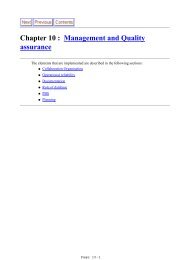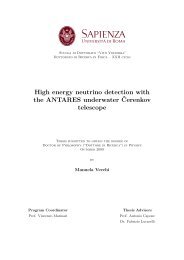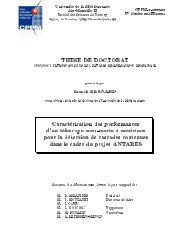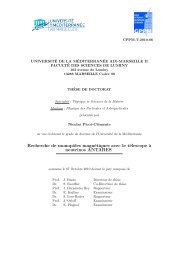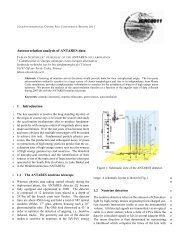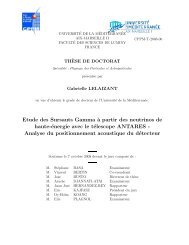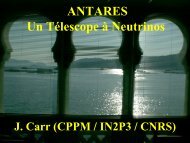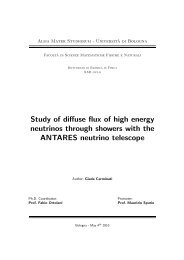Mohamad-Ziad Charif - Antares
Mohamad-Ziad Charif - Antares
Mohamad-Ziad Charif - Antares
- No tags were found...
Create successful ePaper yourself
Turn your PDF publications into a flip-book with our unique Google optimized e-Paper software.
Anchor & BuoyEach line is anchored to the sea bed via a bottom string socket (BSS) , every BSSis as well equipped with a autonomous transponder that can help to position itselfwith reference to acoustic transponders located around the detector . Each lineis equipped with an anchor as well with a buoy, the role of the buoy is simply tohold the line straight. On a side note, the BSS of lines 7 and 8 hold a laser beaconwhich is use to do inter-line offset calibration, this will be discussed in the nextsection .3.2.1.2 CalibrationAs previously mentioned the LED’s and hydrophones installed on the stories andthe BSS’ are used to calibrate the detector. The ANTARES detector calibration isdivided into three separate but yet important calibration systems:Positioning and pointingIn order to accurately pinpoint astrophysical objects with reference to ANTARESa positioning and pointing calibration should be performed. This is done withthe LFLBL (Low Frequency Long BaseLine positioning system[91]) acoustic positioningsystem found on the BSS of every line. This system uses frequenciesbetween 8 and 16 KHz , this range of frequencies helps determine the overallposition of ANTARES by triangulation with five transponders located around thedetector with an addition of a ship positioned above the detector. With the help ofmore than 100 GPS positioning calculation done on the ship, an absolute positionof ANTARES relative to earth with an accuracy of 1 m and an accuracy of 1 ◦ and0.1 ◦ degrees in horizontal and vertical pointing.In addition to using the acoustic system to calibrate the pointing of ANTAREStwo other methods are implemented to independently verify the results.Moon ShadowAs the Moon rotates around Earth it will block cosmic rays (Figure 3.16), this willresults with fewer than expected number of down-going muons in the direction ofthe Moon. So one method of verifying the pointing of ANTARES is to look fora deviation of the deficit of down-going muons in respect to the expected Moonposition for ANTARES. It is expected that with enough data (at least 5 years ) wewould be able to improve the horizontal pointing accuracy below 1 ◦ .48



